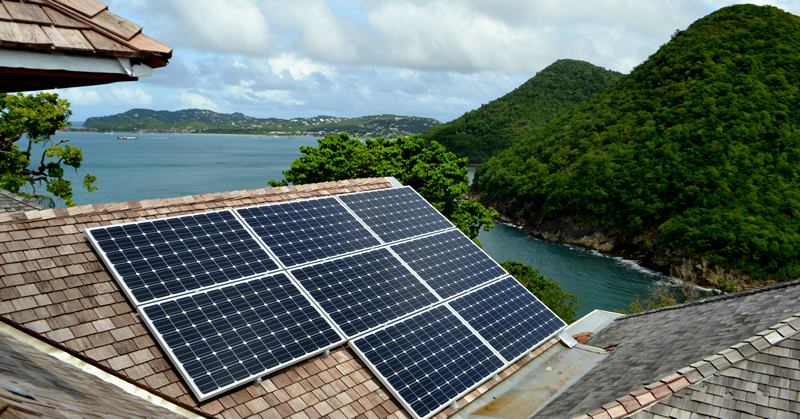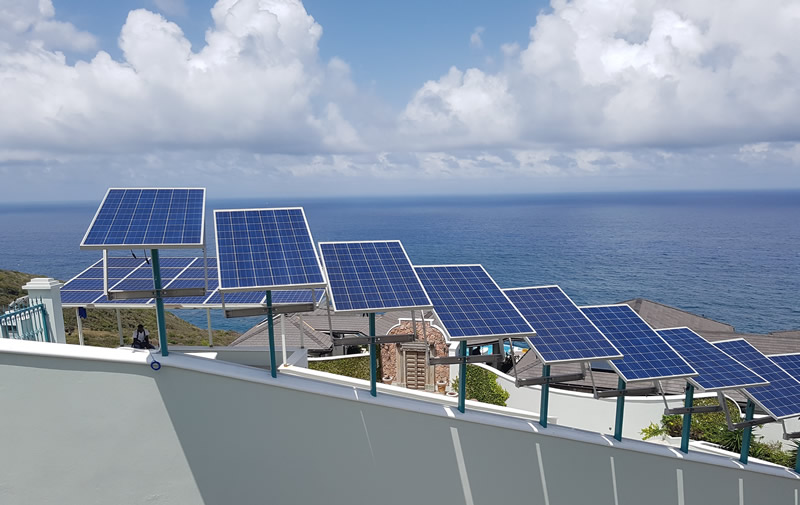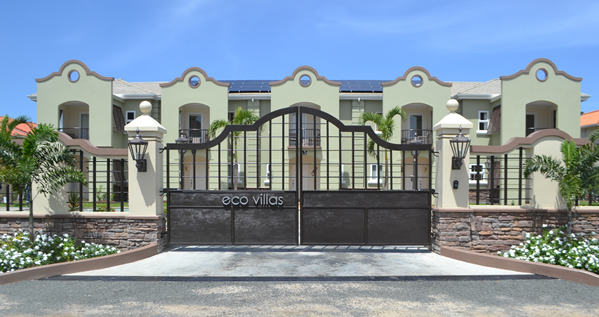
Photo courtesy of Denell Florius, Eco Carib, Inc
It’s October, and that means it’s still hurricane season in the Caribbean. The people of the region and their governments can be forgiven for viewing each tropical depression with dread. The hurricanes that battered Caribbean islands in 2017 have imposed devastating economic and personal hardships, with effects that will linger for years.
Monster hurricanes have prompted intense scientific study of the complex relationships between fossil fuel burning, climate change and the strength of tropical storms. Meanwhile, fossil fuels also create financial challenges for island economies.
Most Caribbean islands are heavily dependent upon diesel oil for electricity generation, leaving island governments and utilities vulnerable to unpredictable fluctuations in world oil prices and delivery interruptions caused by severe weather. Aside from the energy security issues, the import of expensive liquid fuels to generate electricity imposes burdensome cost-of-living expenses on economically disadvantaged residents and stifles economic opportunity. For example, the Caribbean regional average for residential electric utility rates is a whopping US$0.33 per kilowatt hour (kWh), nearly three times more expensive than the US average of US$0.12/kWh.
Renewable Energy in the Eastern Caribbean
In the Eastern Caribbean, countries are implementing pilot projects and examining new policies to promote renewable energy and improve their local economies as well as their resilience to severe weather events. Specifically, the island nations of St. Lucia, St. Vincent and the Grenadines and Grenada – are exploring the most promising business models for scaling up commercial and industrial solar (C&I) photovoltaics (PV) and studying ways to eliminate barriers to clean energy development.
Most Eastern Caribbean utilities have a customer renewable energy program that allows them to interconnect solar PV with the utility grid and be compensated for electricity production. St. Lucia has a net-metering program, and Grenada has a net billing program. In addition, the utilities are embarking on utility owned solar PV projects with recent accomplishments including a St. Lucia Electricity Services Limited (LUCELEC) 3MW Solar Farm, the first utility-scale solar project in Saint Lucia,1 and the Grenada Electricity Services Ltd (GRENLEC) 937 kW aggregated solar project consisting of multiple rooftop, carport, and ground-mount solar installations.2 The utilities are also piloting solar-plus-storage projects to better understand the energy and resilience value storage can offer, with St. Vincent Electricity Services Limited (VINLEC) moving forward with its first Solar-Battery Storage Microgrid System in the Grenadines.3 While progress in utility-led solar PV and solar-plus- storage projects is encouraging, growth in C&I customer-sited solar remains limited.
The countries of the Eastern Caribbean benefit from sharing experiences and observing rapidly advancing solar development in other countries. But, Emily Chessin of the Cadmus Group says, “Small Caribbean island nations face their own particular challenges which need to be addressed in a way that is tailored to their national context.”
St. Vincent and the Grenadines
In St. Vincent, residential utility rates start at US$0.26/ kWh, and commercial customers pay even more.4 In 2010 the island government adopted a National Energy Action Plan (NEAP),5 and recently updated the goal to generating 60% of electric output from renewable energy sources by 2020. St. Vincent’s state-owned, vertically integrated utility, VINLEC, does have some hydroelectric resources which contribute almost 10% of its electricity requirements.6 The hydro power is backed by diesel generation which becomes especially critical during the dry season. However, the diesel generators are aging, which is one reason the government is looking to supplement its electricity generation resources with renewable energy. St. Vincent and the Grenadines is planning to meet 50% of electricity demand from geothermal. In addition, VINLEC is renovating existing hydro power facilities to improve efficiency and generation capacity as well as enabling the installation of small-scale photovoltaics (PV) in the private and public sectors.

Photo courtesy of Denell Florius, Eco Carib, Inc
St. Lucia
In nearby St. Lucia, which is almost entirely fossil-fuel dependent, residential utility rates are three times the U.S. average at US $0.33/kWh. The utility, LUCELEC, is privately owned although the island government holds a minority share. St. Lucia has set a goal goal of 35% of electricity generation from renewables by 2025.7 St. Lucia has abundant solar resources and important geothermal potential from the volcano that sits in the middle of the island. LUCELEC is completing the first ever utility scale solar project in St. Lucia, but outside of the project has relatively little renewable energy development. In 2016, the government of St. Lucia in partnership with LUCELEC, and with support from the Rocky Mountain Institute and the Carbon War Room, and the Clinton Climate Initiative, completed the National Energy Transition Strategy (NETS),8 the country’s guiding document and energy roadmap. The NETS paves the way for a sustainable, reliable, cost-effective and equitable electricity sector using the island’s local resources. In the NETS, RMI concluded that the best future option may be a combination of utility-scale and distributed renewable energy.9
Grenada
The situation in Grenada is similar to that of St. Lucia – a fossil-fuel dependent economy with high electricity prices at US$0.34/kWh and US$0.44/kWh for commercial customers. The utility is investor-owned and while the government of Grenada has set a renewable energy goal of 20% renewable energy by 2020, the utility has set its own higher goals. Grenada also has significant renewable energy resources including solar, wind and geothermal, and has embarked upon some renewable energy projects. GRENLEC currently operates 2.36 MW of renewable energy, representing 7% of peak demand.10 GRENLEC states an interest in moving forward with more renewable energy projects in solar and wind, and customer owned generation, but there is currently regulatory and commercial uncertainty for GRENLEC and any new investments are currently stalled.
Barriers to the Development of Commercial Solar in the Eastern Caribbean
Given the high cost of fossil fuel-generated electricity and the abundant renewable energy resources, why haven’t Eastern Caribbean countries made more progress in their transition to renewable energy? Despite government commitments and utility actions their mixture of ownership models, the utilities of the Eastern Caribbean are all facing similar types of challenges, not the least of which is extreme weather that can threaten investments in renewable energy infrastructure, and lack of space for PV arrays on small islands.

Photo courtesy of Denell Florius, Eco Carib, Inc
Self-consumption Threatens Revenues for Small Utilities
One of the most important challenges, according to Chessin, is the small scale of the utilities on these Caribbean islands, sometimes limited to serving tens of thousands of customers. This means that customer-sited solar PV projects have an immediate impact upon revenues. “This is creating some opposition to rapid development of customer-sited solar development among these utilities for several reasons,” she says, and points out that commercial and industrial customers are a vital source of revenue for utilities. They include hotels, resorts, airports and large stores, farms, breweries and a bit of industry on the larger islands.
Local solar developer Denell Florius, CEO and Co-Founder of EcoCarib in St. Lucia says for utilities, “This is a massive opportunity for them, a chance to update their systems and move into the future.” He adds, “The C&I customers are really the drivers of this because we are a following culture. Most people will observe what the bigger players are doing and follow them.”
High Levels of Distributed Generation Raise Issues for Utilities
1) Customers that generate and consume their own electricity buy less electricity from the utility, which under current rules directly reduces the utility’s revenues. These customers also require compensation from the utility for the electricity that is supplied to the grid. Depending on the compensation value this can be more than what the utility pays for their own generation. This results in a new cash outflow for the utility.
2) Customers rely on the utility to provide electricity and stabilize their system. The total amount the customer is paying to the utility may not reflect the cost to the utility of maintaining and operating the grid and being available 24/7 to provide backup power.
3) As there is increasing uptake of customer-sited solar PV, revenues decrease while the utility’s cost of cost of maintaining and operating the grid have not changed; they still need to recover their costs. The utility may have to respond by raising customer electricity tariffs, thereby shifting an increasing proportion of costs to those customers who do not have a solar PV system.
4) There is also concern that high levels of customer-sited solar PV will lead to grid stability issues.
As a response, utilities are implementing or considering an approach that requires customers to sell all of their generation and purchase all their electricity from the utility, thereby reducing some of the revenue erosion concerns. St. Lucia, for example, is considering this “buy-all, sell-all” policy and it would effectively bar self-consumption. In order to avoid these constraints, some customers are considering grid defection. That is still relatively minimal but it’s starting to occur among tourist destinations that want to project a “green” image. It could pose financial and technical operational issues to the utility if enough customers – encouraged by declining storage prices – leave the utility provider.
There are some policies to encourage solar PV investment on these islands including waivers on import duties and value added tax, net metering, and net billing schemes. But, utilities and island governments haven’t yet determined a mix of policies, regulations, and incentives that would balance the priorities to encourage customer-sited solar PV development while ensuring financial survival of the utilities, and preventing cost shifts to customers that do not have solar PV systems.
Caribbean Regulatory Reform Could Encourage Solar PV for C&I Sector
Other important barriers to new solar PV development in the Eastern Caribbean include:
• Capacity limits on C&I PV projects: Caps range from 25 kW to 100 kW . This is often not enough to service the electrical needs of commercial customers or justify their investment in solar PV.
• The level of compensation that PV generators receive for selling power to the grid can sometimes make it challenging for projects to pencil out.
• Import regulations: Burdensome paperwork and procedural delays; various restrictions, such as a rule that requires imported equipment to be allocated to specific projects. This can discourage the creation of local inventory that can conveniently supply local solar developers.
• Cumbersome or confusing process for approval, licensing and interconnection of solar projects.
• Shortage of experienced labor.
Lack of consumer awareness on the opportunities and benefits of solar PV.
Research Will Identify Promising C&I Business Models
HOMER Energy is participating in a World Bank-funded study of the most promising business models for scaling up commercial and industrial solar (C & I) photovoltaics (PV) in the Eastern Caribbean. The study parallels development of three World Bank-sponsored solar PV projects: a hospital in St. Lucia, a school in St. Vincent, and a Community College in Grenada. These solar PV projects will increase the amount of renewable energy in each country’s electricity mix while helping them reach their energy security, resilience, and sustainability goals.
Led by Worldwatch Institute, the study and accompanying report relies on expert technical insight from HOMER Energy, Nathan Associates, and The Cadmus Group to extend the success of the above projects and support the future growth of the nascent C&I solar industry in the Eastern Caribbean. The research will examine the costs and benefits of increased commercial solar PV and recommend ways to reduce the barriers to solar investments. John Glassmire, Director of Energy Engineering at HOMER Energy, says, “We will compare different ownership models for solar PV and their financial impact on customers and utilities, examine barriers to scaling up commercial solar, and explore potential solutions. The HOMER software suite is valuable in this respect, because it will allow us to model how different customer-sited PV options affect the viability and benefits of these projects.”
Research on Business Models Aims to Improve Financing Prospects for Caribbean Solar
Scarce local financing is the last challenge that solar PV for the C&I sector faces in the Eastern Caribbean. Local financial institutions don’t have adequate capital or the roadmaps that have evolved for renewable energy financing in other countries. That’s another reason why the research project project is focused on determining the most promising business models for advancing solar – and eventually storage – for C&I customers. Among the different business models that are being studied are:
• Utility-owned or leased individual rooftop solar projects or aggregated rooftop solar projects
• Community solar – could be utility, community, private or hybrid ownership
• Private-sector ownership – this would include customer ownership, various third-party ownership / leasing models including Independent Power Producers (IPP) – already familiar to the utilities through fossil fuel-based production and Power Purchase Agreements (PPA).
Research participants will also be looking at the “best practices” in other Caribbean countries such as Barbados, that have rapidly evolving solar industries.
 HOMER International Microgrid Conference, October 8-10 2018
HOMER International Microgrid Conference, October 8-10 2018
Designing and developing microgrid and grid-tied systems for islands will be one of the key themes at the HOMER Microgrid Conference. The presentations will include:
“Business Models for C&I Solar PV in the Eastern Caribbean,” Emily Chessin, The Cadmus Group.
“Microgrids in Puerto Rico: How Community Finance is Delivering,” Alison Mason, SunJuice Solar.
“Australian High Penetration RE Case Studies; King Island Flinders Island and Rottnest Island,” James Hamilton, Centre for Renewable Energy and Power Systems, University of Tasmania
For more information and to register for the conference please visit us at www.MicrogridConference.com/registration
- https://stluciatimes.com/2018/04/13/3-mw-solar-farm-now-feeding-lucelec-grid
- https://wrbenterprises.com/grenlec-awarded-best-distributed-generation-project-at-caribbean-renewable-energy-forum
- https://rmi.org/press-release/mayreau-microgrid-project-kicks-off
- https://www.nrel.gov/docs/fy15osti/64127.pdf
- http://www.gov.vc/images/PoliciesActsAndBills/SVGEnergyActionPlanSvgFirstEdition.pdf
- Ibid
- http://www4.unfccc.int/ndcregistry/PublishedDocuments/Saint%20Lucia%20First/Saint%20Lucia%27s%20INDC%2018th%20November%202015.pdf
- http://www.govt.lc/media.govt.lc/www/resources/publications/saint-lucia-nets-executive-summary-final.pdf
- https://rmi.org/saint-lucias-journey-renewable-future/
- http://grenlec.com/ResourceCentre/MediaReleases/TabId/125/ArtMID/661/ArticleID/1191/Addressing-the-Challenges-and-Options-for-Renewable-Energy-.aspx
